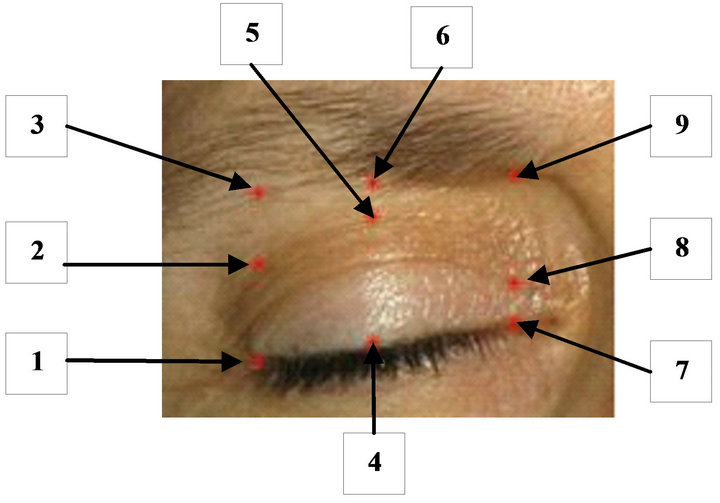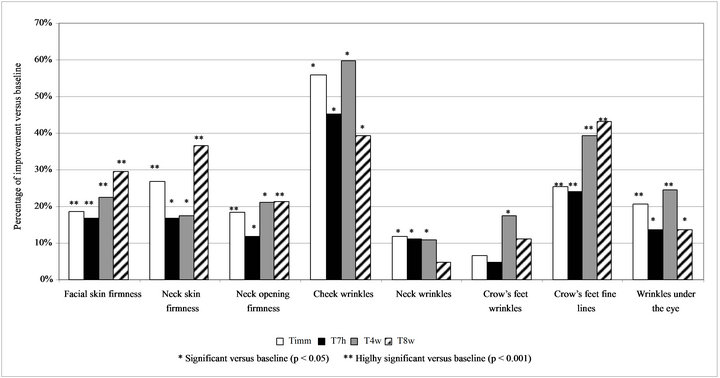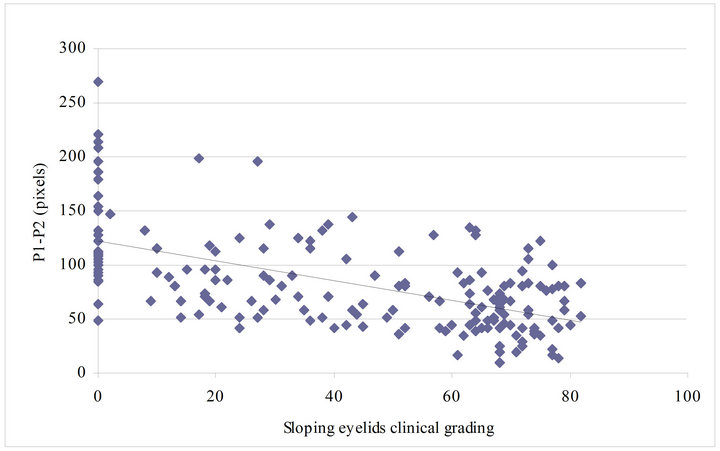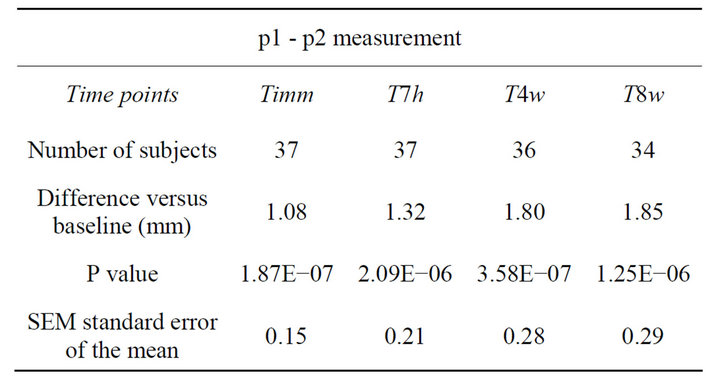Journal of Cosmetics, Dermatological Sciences and Applications
Vol.3 No.3(2013), Article ID:35869,7 pages DOI:10.4236/jcdsa.2013.33032
Cosmetic Lifting Effect of a Formula Combining Tetrahydroxypropyl Ethylenediamine, Ononis Spinosa and Glycerin as Shown by a New 2-D Imaging Method
![]()
1Johnson & Johnson Santé Beauté France, Issy-les-Moulineaux, France; 2Independant Dermatologist, Pairs, France.
Email: rroure@its.jnj.com
Copyright © 2013 Romain Roure et al. This is an open access article distributed under the Creative Commons Attribution License, which permits unrestricted use, distribution, and reproduction in any medium, provided the original work is properly cited.
Received June 25th, 2013; revised July 26th, 2013; accepted August 3rd, 2013
Keywords: Facial Sagging; Wrinkles; Tetrahydroxypropyl Ethylenediamine; Immediate Effect; Long-Lasting Effect; 2-D Imaging; Lift Measurement
ABSTRACT
Facial sagging is a major aging change that affects the overall shape of the face. Sagging can negatively impact self-perception and consequently quality of life. In order to fight against this aging sign, we developed a combination of three active ingredients: Tetrahydroxypropyl Ethylenediamine (THPE), Ononis Spinosa extract and Glycerin. In a clinical study, we assessed the efficacy of this association on facial sagging and wrinkles, with a special focus on immediate and lasting effects. Thirty-nine women applied the tested product daily during an eight-week treatment period. Clinical grading by experts and a new, easy to operate, 2-D imaging method were performed at different time points. The 2-D imaging method measured the upper eyelid lifting effect. The results showed an immediate and significant improvement in sagging and wrinkle parameters; these benefits were still observed seven hours after the first application. Results also showed a significant long-term improvement. The lifting effect calculated from the 2-D pictures was 1.08 mm immediately after application; the same method showed a 1.80 mm lifting effect following the eight-week treatment period. These results suggest that a skin care product combining THPE, Ononis Spinosa and Glycerin properties may be used to reduce sagging as well as wrinkles with both immediate and long term benefits.
1. Introduction
With aging, one of the most significant changes in facial appearance, together with wrinkles, is sagging skin. Facial sagging can decrease self-perception and reduce the overall physiological quality of life. Different parts of the face such as the cheeks, the jaw line as well as the upper and lower eyelids can be affected. The mechanism of sagging is not yet fully understood. It seems to be associated with a reduction of skin elasticity in addition to the effects of gravity. The loss of collagen fibers, which provide structural stability, and the degradation of elastin fibers, which give elasticity, may thus be involved. Changes in muscle functions, and in fat mass [1] may also lead to skin laxity.
Various methods have been developed to evaluate sagging, and consequently the efficacy of active firming ingredients. Subjective methods, such as self-assessment and clinical grading (performed by experts) of sagging parameters are the most commonly used. Other wellknown methods quantify the changes in skin mechanical properties using different devices. For instance, cutometers, reviscometers or indentometers allow the evaluation of skin elasticity and firmness. Imaging skin surface topography is another way to evaluate aging signs. One example is three-dimensional image analysis methods that have been developed to assess sagging of cheeks and lower eyelids [2,3]. All objective methods are frequently combined with the aforementioned subjective ones. By providing quantitative data, they are expected to enhance the accuracy of cosmetic product assessments.
To fight facial sagging, different active ingredients have been investigated. Among them, high molecular weight polymers, such as proteins and polysaccharides, act as immediate skin tightening agents. Those polymers form a film on the skin, leading to a stratum corneum retraction [4]. However, this reaction does not show any long-term efficacy. To our knowledge dimethylaminoethanol (DMEA) is the only ingredient, in addition to Tetrahydroxypropyl Ethylenediamine (THPE), which may have both immediate and long-lasting effects, even if the immediate effect of DMAE has not consistently been clinically demonstrated [5-7]. Some other ingredients have been reported to improve skin firmness through different actions, but only after repeated applications. For example, a formulation containing Creatine and Folic acid exerted sustained effects on collagen metabolism [8]. Retinol, the best known anti-aging molecule, may have an effect on sagging by increasing elastin production [9]. Soybean extracts have also been shown to induce elastin production, and to inhibit elastases [10]. Lastly, an in vitro study demonstrated that C-xyloside is able to increase glycosaminoglycan synthesis [11]. All these active ingredients share a common feature: they act on dermal extra cellular matrix components to improve the skin’s mechanical properties. One of the major issues in skin firming is now to provide active ingredients that combine both immediate and long-lasting benefits.
In our study, we investigated the effect of a combination of THPE, Ononis Spinosa and Glycerin on sagging skin. The efficacy of THPE, which acts through keratinocyte contraction, has previously been described in vitro and in in vivo studies [12]. Glycerin, also known as glycerol, is widely incorporated into cosmetic preparations due to its moisturizing properties. Ononis Spinosa (or spiny restharrow) is used in skin care products as an astringent. Our in vitro studies (not published) showed that Ononis Spinosa might also have an effect on elastin. The aim of this study was to assess the benefits of such a combination on facial sagging, with special focus on immediate and lasting effects. Since the eye area has been reported to highly influence our perception of aging [13], we mainly investigated the effects of the tested product on eyelids. Thus, we developed a simple new method, based on 2-D imaging, to assess upper eyelid lifting.
2. Materials and Methods
An eight-week clinical study was performed to assess the efficacy of a combination of three active ingredients: Ononis Spinosa, THPE and Glycerin, with a special focus on immediate and long-lasting effects. The study was conducted from October 2008 to January 2009. Lifting and skin aging parameters (e.g. skin lifting, skin firmness, fine lines and wrinkles) were evaluated by clinical grading and 2D pictures.
2.1. Subjects
Thirty nine women volunteers, with Fitzpatrick classification I to IV, were recruited from a panel of 7000 subjects who responded to a questionnaire concerning their medical history, skin type and skin care habits. To be included in the study, women had to be in good health and over 45 years old. Subjects had dry skin and wrinkles, with a loss of firmness and facial sagging. All volunteers signed an informed consent form.
Subjects refrained from applying any anti-aging product on their face, neck and neck line one month prior to the study and used a dry skin moisturizing cream. No skin care product was applied to the face for three days before the test. During the eight-week treatment period, they used the tested product for full face, full neck and neck line applications, once a day in the morning. No other cosmetic products were used and sun exposure was avoided. On measurement days the subjects did not wash their face with cosmetic product nor apply the tested product.
2.2. Tested Product
The tested product contained three active ingredients: THPE 2.5%, bugrane (Ononis Spinosa) 0.1%, and Glycerin 5%.
2.3. Measurements
Clinical grading of sagging and other aging signs such as wrinkles and fine lines, as well as distance measurements on 2-D pictures were evaluated in this study. These measurements were performed before application (T0, baseline), then immediately (Timm) and seven hours (T7h) after the first application, and after four (T4w) and eight weeks (T8w) of daily topical application of the tested product.
2.3.1. Clinical Grading
A trained expert assessed the subjects’ faces and necks for a series of parameters, using a visual analog scale ranging from 0 to 100. The lifting and firmness parameters were skin and neck lifting (0 corresponding to “not lifted” and 100 to “very lifted”), skin firmness on the face, neck and neck line (0 corresponding to “not firm at all” and 100 to “very firm”), jaw line (0 corresponding to “strong sagging” and 100 to “oval well drawn oval”), double chin (0 corresponding to “no double chin” and 100 to “very marked”), eye opening (0 corresponding to “not opened” and 100 to “very opened”) and sloping eyelids (0 corresponding to “no sloping eyelids” and 100 to “very sloping eyelids”). The wrinkles and fine lines parameters were crow’s feet wrinkles and fine lines under the eyes wrinkles, neck wrinkles, cheek wrinkles and eyelid fold (0 corresponding to “no wrinkles or no folds” and 100 to “a lot of wrinkles or very marked folds”). All assessments were visual, except for skin firmness that was a tactile assessment.
2.3.2. 2-D Pictures
Frontal and sideways 2-D pictures were taken (eyes opened and eyes closed) in order to measure the cosmetic lifting effect on the eye area. We used three Canon Power Shot G9 digital cameras. Pictures were taken with visible light flash at each time point of the study. In order to obtain comparable pictures, subjects were asked to sit in the same defined position at each measurement time and to place their face between earflaps. To assure consistent face position, special software displayed a ghost image, taken at baseline, on the screen’s background. The technician could thus easily and precisely reposition the subject’s face before shooting the pictures at each time point.
High-resolution pictures were displayed on a 24-inch wide screen. An expert reviewer manually selected nine points around the eye area as landmarks. The Euclidian distance between those points was then calculated. Cosmetic lifting effect was defined as a increase of the distance between a pair of given points at different time points. Figure 1 showed marks used to calculate distances.
2.4. Statistical Analysis
Mean values and standard deviations were determined at each time point. Parameter variations were expressed as a percentage, relative to baseline. Comparisons were performed using the Student’s t test versus baseline, at the p ≤ 0.05 significant level. Pearson correlation coefficient and p-value were computed to compare lift measurement with clinical grading (sloping eyelids). This test was applied to raw data values. Statistical analyses were performed using Microsoft® Excel 2000.
3. Results
All 39 subjects completed the study. The tested product

Figure 1. Cosmetic lifting effect: marks used to calculate distances.
was well tolerated, although three women reported moderate skin reactions that lasted a few days.
3.1. Clinical Assessment
Immediately after the first application, the tested product showed statistically significant (p ≤ 0.5) lifting and firming effects versus baseline. Thus, were improved: skin lifting (+12.6%), neck lifting (+13.4%), eye opening (+11.3%) as well as face firmness (+18.5%), neck firmness (+26.8%) and neckline firmness (+18.2%). All six parameters were still significantly improved 7 hours after the first application versus baseline. Significant impro vement in all nine lifting and firmness parameters assessed was seen following four and eight weeks of daily application. For example, the face lifting and the face skin firmness parameters respectively increased by 23.6% and 22.2% after four weeks. Figure 2 showed the improvements in the lifting parameters observed at each measurement time.
Moreover, the tested product also showed significant improvement in the appearance of fine lines and wrinkles. Immediately after application, crow’s feet fine lines (+25.4%), under eyes wrinkles (+20.4%), eyelid folds (+22.8%) cheek wrinkles (+55.8%), neck wrinkles (+11.8%), were significantly improved versus baseline. Significant effects were still observed for these 5 parameters 7 hours after the first application. All these parameters were significantly improved after four weeks of application, and five out of six after eight weeks. After eight weeks, the improvement observed on crow’s feet fine lines and eyelid folds was respectively, 43.1% and 34.2% versus baseline. Figure 3 showed the improvements in firmness, wrinkles and fine line parameters observed at each measurement time.
3.2. 2-D Images
Thirty-nine subjects completed the study, but, due to technical problems, 2-D image measurements were performed on 37 women immediately and 7 hours after application, on 36 four weeks later, and on 34 at the end of the eight-week period.
Among the various Euclidian distances calculated from the 2-D pictures, we retained the distance between points p1 and p2 (p1 - p2) that best represented sloping eyelids and was one of our clinically graded parameters. A statistically significant increase in p1 - p2 distance versus baseline was measured immediately after the first application (average = 1.08 mm). An average 1.85 mm lift was obtained at the end of the eight-week application period. The changes in p1 - p2 distances at each time point are presented in Table 1. Figure 4 showed pictures of the upper eyelid at baseline, and after four and eight

Figure 2. Clinical grading: percentage of improvement versus baseline of lifting parameters.

Figure 3. Clinical grading: percentage of improvement versus baseline of firmness, wrinkles and fine lines parameters.
weeks of topical treatment.
3.3. Correlation between Lifting Data and Clinical Grading (Sloping Eyelids)
The calculated Pearson correlation coefficient between the lift measurement of the upper eyelid and the clinical grading of sloping eyelids was 0.58, showing a significant (p < 0.0001) negative correlation. This correlation between the two methods is presented in Figure 5.
4. Discussion
Facial sagging is, with wrinkles, one of the critical signs of aging against which women seek to fight. That is why cosmetics companies continue to screen and test active ingredients that potentially reduce it. Assessing this potential effect on skin sagging requires reliable and accurate methods. Among them, clinical assessment by experts is a major and essential way to evaluate the improvement of sagging, since it is directly based on the

Figure 4. Cosmetic lifting effect: pictures of the upper eyelid area at baseline and after four and eight weeks. The arrow shows the p1-p2 distance.

Figure 5. Correlation between the upper eyelid lifting measurements and the clinical grading of sloping eyelids. Pearson R = 0.582, p = 7.57E-18.

Table 1. Lift measurement with 2-D imaging method: increase in the p1 - p2 distance versus baseline at each time point.
visually perceived effects. Moreover clinical grading can be applied to the whole face and neck. However, additional methods are often needed to provide a more objective and quantitative approach.
Assessing skin’s biomechanical properties, through shear waves or suction measurement represents examples of such a quantitative approach [14]. These methods provide reliable measurements of skin elasticity and firmness, which are presumed to be implicated in sagging. Nevertheless, and as far as we know, measurements are generally performed on the forearm or the cheek. Changes in the mechanical properties in these particular skin areas may not reflect the visually perceived changes over the entire face. Unfortunately, the eyelid seems to be too thin and fragile an area to be evaluated through such methods, which require repeated skin contacts with various probes.
Photography is recognized as one of the easiest and more effective way to communicate the benefits of treatment progression [15]. In our study, we developed a non invasive and objective method based on digital photography to quantify the effect of three combined active ingredients on upper eyelid sagging. We measured the lifting effect using calibrated and reproducible 2-D pictures of subjects’ upper eyelids taken at different time points. Given that this lift measurement is negatively correlated with clinical grading of sloping eyelid (Pearson R = 0.582, p < 0.0001), we may conclude that our new method is a reliable and complementary tool in the assessment of anti-sagging properties in cosmetic products. Our 2-D imaging system enables accurate measurement of lifting effects, while clinical grading provides an overall perception of effects on aging and sagging.
These two complementary assessment methods showed the immediate and long-lasting anti-aging effects of the tested product. The immediate effect was an improvement in both facial sagging and wrinkles and these benefits persisted seven hours after the first application. For example, the lift measurement was 1.08 mm immediately following application and 1.32 mm after seven hours. Moreover we noted an improvement in lift measurements after four (1.80 mm) and eight weeks (1.85 mm) of daily topical treatment compared to the immediate measurement. This suggests additional benefits of repeated applications of the combined active ingredients.
The anti-aging benefits of THPE are well documented. A previous clinical study demonstrated its significant firming effect 45 minutes after a first application and after four and eight weeks of daily treatment [12]. At the cellular level, THPE has been shown to induce keratinocyte contraction, thus decreasing cell surface areas. This contractile effect may account for the immediate skin lifting effect. Very little scientific research has been published about Ononis Spinosa. The results of our in vitro studies (not published) suggest that this ingredient acts through elastin synthesis, and therefore does not induce immediately visible results. Ononis Spinosa action may be involved in the enhanced cosmetic lifting observed after 4 and 8 weeks. The numerous effects of glycerin, a skin component, have been widely reported. First of all glycerin is a well-known moisturizing ingredient. It improves the stratum corneum barrier properties, resulting in decreased skin irritation [16]. Glycerol also acts on skin’s mechanical properties. Improvement of skin elasticity by glycerol, measured by cutometry, has thus been reported. This third ingredient may therefore reinforce the anti-aging benefits of THPE and Ononis Spinosa.
5. Conclusion
In conclusion, measuring cosmetic lifting effect on upper eyelids with our new 2-D imaging method appears to be simple, accurate and reliable. It may be useful in quantifying the visually perceived effects of anti-sagging cosmetic products. As far as we know, no comparable method has yet been described. Combining this 2-D imaging method with clinical grading, we demonstrated the benefits of three combined active ingredients. Thus, the association of THPE, Ononis Spinosa and glycerin shows both immediate and long lasting effects on two major signs of aging: sagging and wrinkles.
6. Acknowledgements
We thank Virginie de Fontgalland for editing and reviewing this manuscript. The authors are full-time employees of Johnson and Johnson Santé Beauté France. They do not have any conflict of interest.
REFERENCES
- T. Ezure, J. Hosoi, S. Amano and T. Tsuchiya, “Sagging of the Cheek Is Related to Skin Elasticity, Fat Mass and Mimetic Muscle Function,” Skin Research and Technology, Vol. 15, No. 3, 2009, pp. 299-305. doi:10.1111/j.1600-0846.2009.00364.x
- Y. Fukuda, T. Fujimura, S. Moriwaki and T. Kitahara, “A New Method to Evaluate Lower Eyelid Sag Using Three-Dimensional Image Analysis,” International Journal of Cosmetic Science, Vol. 27, No. 5, 2005, pp. 283- 290. doi:10.1111/j.1467-2494.2005.00282.x
- N. Saito, T. Nishijima, T. Fujimura, S. Moriwaki and Y. Takema, “Development of a New Evaluation Method for Cheek Sagging Using a Moire 3D Analysis System,” Skin Research and Technology, Vol. 14, No. 3, 2008, pp. 287- 292. doi:10.1111/j.1600-0846.2008.00292.x
- J. Jachowicz, R. McMullen and D. Prettypaul, “Alteration of Skin Mechanics by Thin Polymer Films,” Skin Research and Technology, Vol. 14, No. 3, 2008, pp. 312- 319. doi:10.1111/j.1600-0846.2008.00296.x
- B. Sommerfeld, “Randomised, Placebo-Controlled, Double-Blind, Split-Face Study on the Clinical Efficacy of Tricutan on Skin Firmness,” Phytomedicine, Vol. 14, No. 11, 2007, pp. 711-715. doi:10.1016/j.phymed.2007.09.015
- I. Uhoda, N. Faska, C. Robert, G. Cauwenbergh and G. E. Pierard, “Split Face Study on the Cutaneous Tensile Effect of 2-Dimethylaminoethanol (Deanol) Gel,” Skin Research and Technology, Vol. 8, No. 3, 2002, pp. 164-167. doi:10.1034/j.1600-0846.2002.10295.x
- C. Bertin, C. Robert, M. Jousselin and N. Issachar, “Treating Wrinkles with Dimethylaminoethanol, Retinol and Mineral Salts,” Cosmetics & Toiletries, Vol. 123, No. 4, 2008, pp. 75-80.
- R. I. Peirano, V. Achterberg, H. J. Dusing, M. Akhiani, U. Koop, S. Jaspers, et al., “Dermal Penetration of Creatine from a Face-Care Formulation Containing Creatine, Guarana and Glycerol Is Linked to Effective Antiwrinkle and Antisagging Efficacy in Male Subjects,” Journal of Cosmetic Dermatology, Vol. 10, No. 4, 2011, pp. 273-281. doi:10.1111/j.1473-2165.2011.00579.x
- D. Rossetti, M. G. Kielmanowicz, S. Vigodman, Y. P. Hu, N. Chen, A. Nkengne, et al., “A Novel Anti-Ageing Mechanism for Retinol: Induction of Dermal Elastin Synthesis and Elastin Fibre Formation,” International Journal of Cosmetic Science, Vol. 33, No. 1, 2011, pp. 62-69. doi:10.1111/j.1468-2494.2010.00588.x
- R. Zhao, E. Bruning, D. Rossetti, B. Starcher, M. Seiberg and V. Iotsova-Stone, “Extracts from Glycine Max (Soybean) Induce Elastin Synthesis and Inhibit Elastase Activity,” Experimental Dermatology, Vol. 18, No. 10, 2009, pp. 883-886. doi:10.1111/j.1600-0625.2009.00862.x
- N. Pineau, D. A. Carrino, A. I. Caplan and L. Breton, “Biological Evaluation of a New C-Xylopyranoside Derivative (C-Xyloside) and Its Role in Glycosaminoglycan Biosynthesis,” European Journal of Dermatology, Vol. 21, No. 3, 2011, pp. 359-370.
- C. Bertin, A. Nkengne, A. Da Cunha, N. Issachar and A. Rossi, “Clinical Evidence for the Activity of Tetrahydroxypropyl Ethylenediamine (THPE), a New Anti-Aging Active Cosmetic,” Journal of Drugs in Dermatology, Vol. 10, No. 10, 2011, pp. 1102-1105.
- A. Nkengne, C. Bertin, G. N. Stamatas, A. Giron, A. Rossi, N. Issachar, et al., “Influence of Facial Skin Attributes on the Perceived Age of Caucasian Women,” Journal of the European Academy of Dermatology and Venereology, Vol. 22, No. 8, 2008, pp. 982-991. doi:10.1111/j.1468-3083.2008.02698.x
- F. Henry, C. Pierard-Franchimont, G. Cauwenbergh and G. E. Pierard, “Age-Related Changes in Facial Skin Contours and Rheology,” Journal of the American Geriatrics Society, Vol. 45, No. 2, 1997, pp. 220-222.
- F. Kaliyadan, “Digital Photography for Patient Counseling in Dermatology—A Study,” Journal of the European Academy of Dermatology and Venereology, Vol. 22, No. 11, 2008, pp. 1356-1358. doi:10.1111/j.1468-3083.2008.02919.x
- J. W. Fluhr, R. Darlenski and C. Surber, “Glycerol and the Skin: Holistic Approach to Its Origin and Functions,” The British Journal of Dermatology, Vol. 159, No. 1, 2008, pp. 23-34. doi:10.1111/j.1365-2133.2008.08643.x

